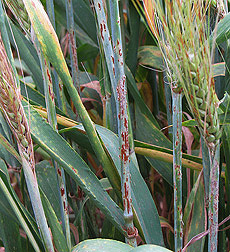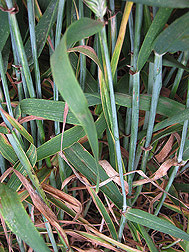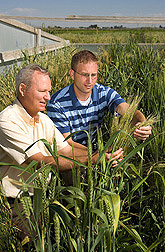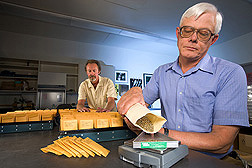International Wheat and Barley Screening
Collaboration Helps Uncover Stem
Rust-Resistant Material
|
|
The Njoro Research Center of the Kenya Agricultural Research Institute (KARI) has been a hotbed of activity these past few years. Since 2005, plant scientists from research organizations around the world, including the Agricultural Research Service, have been sending their countries’ top wheat cultivars and experimental lines to Njoro for testing against Ug99, Puccinia graminis f. sp. tritici, the most virulent race of the stem rust fungus yet to emerge.
Screening of ARS-sent wheat is carried out under a specific cooperative agreement with KARI and the International Maize and Wheat Improvement Center (CIMMYT) in Mexico. ARS, KARI, CIMMYT, and other organizations partner with the Borlaug Global Rust Initiative, an international effort to speed the development and delivery of new rust- and Ug99-resistant cultivars to affected small-grains farmers. The work is especially important to subsistence farmers in parts of Africa and the Middle East where the disease has already arrived and to nations in Ug99’s likely path of spread.
To date, more than 12,000 lines of U.S. wheat—and, to a lesser degree, barley—have been screened, mainly at KARI field plots in Njoro, considered a Ug99 epicenter after the new rust strain was first detected there in 2001. Similar screening takes place at the Kulumsa and Debre Zeit Research Stations in Ethiopia.
|
|
Evaluating U.S. Wheat Germplasm
Mike Bonman, research leader of ARS’s Small Grains and Potato Germplasm Research Unit in Aberdeen, Idaho, oversees rust research conducted by molecular biologist Eric Jackson, agronomist Harold Bockelman, plant pathologist Blair Goates, and postdoctoral plant pathologist Maricelis Acevedo. Goates coordinates the acquisition and shipment of seed for testing. These shipments mainly include advanced breeding lines and heirloom varieties (or landraces) of durum and bread wheats acquired from public and private donors and maintained in ARS’s National Small Grains Germplasm Collection, also at Aberdeen.
“We’re focusing on these first because heirloom spring varieties are easiest to manipulate (use in plant breeding) and perhaps more likely to have novel sources of resistance genes,” says Bonman.
Prescreening of seedlings against local rusts at Aberdeen—and previous evaluations conducted with U.S. races on adult plants at ARS’s Cereal Diseases Laboratory in St. Paul, Minnesota—helped narrow the list of wheat destined for Kenya, based on the plants’ responses to the fungal disease.
|
|
As expected, only the toughest of the tough survived the testing at Njoro. Of 1,768 heirloom wheats submitted since 2005, only 78 (or 4.4 percent) showed resistance to Ug99 at the Njoro site. Still, the prescreening led to identification of more Ug99-resistant wheat accessions than would’ve been achieved from sending randomly selected accessions for testing, says Bonman. This is evidenced by the fact that 7 percent of wheat lines resistant to U.S. races showed rust resistance in Kenya, yet only 1 percent of randomly selected accessions did.
Given Ug99’s reputation as a conqueror of known rust-resistance genes, finding at least some resistance was encouraging—even more so if the survivors are found to harbor new, uncharacterized antirust defenses.
“Some of the landrace accessions we’ve screened in Kenya have shown intermediate to high levels of resistance,” says Acevedo, who also collaborates with ARS plant pathologist Yue Jin at St. Paul. “We’re now crossing these landraces with cultivated wheat to study the inheritance of the resistance and to obtain genetic data from them by using molecular-marker technology.”
On one front, use of these markers will help determine whether new or previously known rust-resistance genes were behind resistance observed in the Kenya-screened wheats. On another front, the marker technology will equip breeders with a fast, powerful tool for selecting and developing new resistant cultivars for farmers—both in the United States, where Ug99 has not yet arrived, and abroad.
New Nursery Houses Rust-Resistant Material
In the next step in the fight against Ug99, the Winter Wheat Stem Rust Resistance Nursery was established by ARS and CIMMYT. The nursery—located in Ankara, Turkey, where CIMMYT coordinates its global winter wheat breeding program—is the first of its kind for winter wheats.
The nursery is a joint effort to distribute 100 lines of winter wheat that have been identified by international scientists as having resistance to Ug99 and its descendants. Thirty of the 100 lines were developed by ARS scientists and have been identified as being resistant to stem rust in Kenya and to U.S. stem rust races.
“We have molecular markers that allow us to predict the presence of some resistance genes. But the resistance must be confirmed in the field in Kenya or at other locations where the pathogen exists,” says David Marshall, research leader of the ARS Plant Science Research Unit in Raleigh, North Carolina, and coordinator of the screening conducted at KARI.
Germplasm from the nursery is currently being distributed to wheat breeders and geneticists in 34 countries around the world. The ARS breeding effort focused on the use of four or five resistance genes, which have been incorporated in various combinations into winter wheat lines. Multiple genes for resistance, according to Marshall, will slow the pathogen’s ability to readily overcome the new varieties breeders develop. While these are all experimental lines, some could be used in the field as cultivars.
“How long these genes can remain effective is key to maintaining resistance to stem rust in the United States,” says Marshall. “The rust pathogen is a moving target; mutations may arise that can overcome the resistance genes. It is of paramount importance that we maintain and accelerate our breeding efforts to keep ahead of this ever-changing pathogen.”
Scientists are also screening barley lines for resistance to stem rust. Though this research is not as advanced as that on wheat lines, Marshall and colleagues have identified several sources of resistance in barley lines currently being tested in Kenya. These lines still need another year of field evaluations before the scientists can confirm their resistance.
Fighting stem rust is truly a team effort. Besides Raleigh, Aberdeen, and St. Paul, other ARS locations involved in rust research include the Plant Science and Entomology Research Unit in Manhattan, Kansas, and the Cereal Crops Research Unit in Fargo, North Dakota.—By Stephanie Yaoand Jan Suszkiw, Agricultural Research Service Information Staff.
This research is part of Plant Genetic Resources, Genomics, and Genetic Improvement (#301) and Plant Diseases (#303), two ARS national programs described at www.nps.ars.usda.gov.
To reach scientists mentioned in this article, contact Stephanie Yao, USDA-ARS Information Staff, 5601 Sunnyside Ave., Beltsville, MD 20705-5129; (301) 504-1619.
"International Wheat and Barley Screening Collaboration Helps Uncover Stem Rust-Resistant Material" was published in the February 2010 issue of Agricultural Research magazine.










